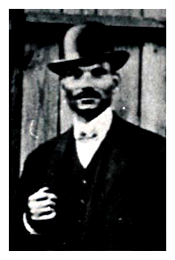

Solomon White
Nickname: Sol
Career: 1887-1912
Positions: 2b, 3b, 1b, ss, of, manager, coach, officer
Teams: minor leagues (1887, 1895), Pittsburgh Keystones (1887, 1892), Washington Capital Citys (1887), New York Gorhams (1889), Cuban Giants (1889-1891, 1893-1894), Genuine Cuban Giants, Philadelphia Big Gorhams (1891), Page Fence Giants (1895), Cuban X-Giants (1896-1899, 1901), Columbia Giants (1900), Philadelphia Giants (1902-1909), Brooklyn Royal Giants (1910), New York Lincoln Giants (1911), Boston Giants (1912), Quaker Giants (1909), Columbus Buckeyes (1920), Cleveland Browns (1924), Newark Stars (1926)
Bats: Right
Throws: Right
Height: 5' 9'' Weight: 170
Born: June 12, 1868, Bellaire, Ohio
Died: August, 1955, New York, New York
National Baseball Hall of Fame Inductee (2006)
While still enrolled at Wilberforce University (1886-1890), he began his baseball career in 1887, as a nineteen-yaer old second baseman for the Pittsburgh Keystones, one of eight teams that were charter members of the League of Colored Baseball Clubs in 1887, and was batting .308 when the league folded after only a week. He then joined the Wheeling, West Virginia, Green Stockings in the Ohio State League, batting .371 as a rookie third baseman.
From this first experience, White continued to play in organized white leagues, either as a individual player, as he did in 1895, when he hit .385 with Fort Wayne, Indiana, in the Western Interstate League, or as a member of a black team representing a host city in an otherwise all-white league, as he did with the Cuban Giants and the New York Gorhams. The Gorhams played in the Middle States League in 1889, and the Cubans represented York, Pennsylvania, in the Eastern Interstate League in 1890 and Ansonia in the Connecticut State League in 1891. During those three seasons, White posted batting averages of .324, .356, and .375, respectively, giving him a lifetime average of .356 in organized baseball.
In addition to playing in the white leagues, he made significant contributions to black baseball, playing with many of the premier teams of the era, including ten championship teams. Those banner-winning ballclubs were the New York Gorhams (1889), the Big Gorhams (1891), the Cuban Giants (1894), the Cuban X-Giants (1897 and 1899), the Columbia Giants (1900), and the Philadelphia Giants (1904-1907). He also played with the Page Fence Giants in 1895, their first full season, and batted .404 during his stint with the team.
However, it is with the Philadelphia Giants that he is best identified. He and Walter Schlichter, a white sportswriter, organized the Philadelphia Giants in 1902, with White holding down the shortstop position as playing manager. A year later the team was in the playoff with the Cuban X-Giants for the eastern championship, but lost the Series, 5 games to 2, with the Cubans' pitching ace, Rube Foster, leading the way. The next season, White lured Foster to Philadelphia, and the playoff results were reversed as Foster won both Philadelphia victories to take the best-of-three series for their first championship. The ballclub, under White's direction, added three more titles, making four consecutive eastern championships. By then he had moved to first base and was not playing full-time. In 1907 he chronicled his experiences in a small volume titled History of Colored Baseball, which covered events through the 1906 season.
An intense player when in action on the diamond, he otherwise demonstrated a calm disposition that served him well as a manager. After leaving Philadelphia, he signed with the Brooklyn Royal Giants for the 1910 season and, when Jess McMahon organized the New York Lincoln Giants the following year, he became their first manager. Later in the season, he gave way to John Henry Lloyd, and retired from baseball in 1912.
After pursuing other activities for the next eight years, he returned to black baseball when the Negro National League was formed in 1920, as secretary of the league's Columbus Buckeyes, leaving to manage the Cleveland Browns when they entered the Negro National League in 1924. His last year in baseball was as a coach with the Newark Stars in the Eastern Colored League in 1926, making him an active participant in the first three black leagues formed, beginning with the League of Colored Baseball Clubs in 1887. After his retirement from the baseball diamond, he wrote a column for the Amsterdam News.
Sol White was posthumously inducted into the National Baseball Hall of Fame in 2006.
Source: James A. Riley, The Biographical Encyclopedia of the Negro Baseball Leagues, New York: Carroll & Graf Publishers, Inc., 1994.

Sol White